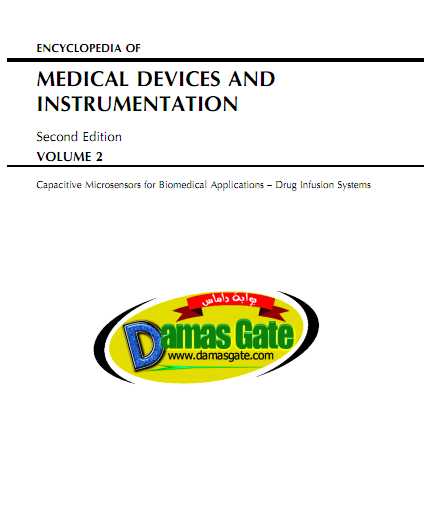Wiley - Encyclopedia of Medical Devices and Instrumentation - Vol. 2

PREFACE
This six-volume work is an alphabetically organized compilation
of almost 300 articles that describe critical aspects of
medical devices and instrumentation.
It is comprehensive. The articles emphasize the contributions
of engineering, physics, and computers to each of the
general areas of anesthesiology, biomaterials, burns, cardiology,
clinical chemistry, clinical engineering, communicative
disorders, computers in medicine, critical care
medicine, dermatology, dentistry, ear, nose, and throat,
emergency medicine, endocrinology, gastroenterology,
genetics, geriatrics, gynecology, hematology, heptology,
internal medicine, medical physics, microbiology, nephrology,
neurology, nutrition, obstetrics, oncology, ophthalmology,
orthopedics, pain, pediatrics, peripheral vascular
disease, pharmacology, physical therapy, psychiatry, pulmonary
medicine, radiology, rehabilitation, surgery, tissue
engineering, transducers, and urology.
The discipline is defined through the synthesis of the core
knowledge from all the fields encompassed by the application
of engineering, physics, and computers to problems in
medicine. The articles focus not only on what is now useful
but also on what is likely to be useful in future medical
applications.
These volumes answer the question, ‘‘What are the
branches of medicine and how does technology assist each
of them?’’ rather than ‘‘What are the branches of technology
and how could each be used in medicine?’’ To keep this work
to a manageable length, the practice of medicine that is
unassisted by devices, such as the use of drugs to treat
disease, has been excluded.
The articles are accessible to the user; each benefits from
brevity of condensation instead of what could easily have
been a book-length work. The articles are designed not for
peers, but rather for workers from related fields who wish to
take a first look at what is important in the subject.
The articles are readable. They do not presume a detailed
background in the subject, but are designed for any person
with a scientific background and an interest in technology.
Rather than attempting to teach the basics of physiology or
Ohm’s law, the articles build on such basic concepts to show
how the worlds of life science and physical science meld to
produce improved systems. While the ideal reader might be
a person with a Master’s degree in biomedical engineering or
medical physics or an M.D. with a physical science undergraduate
degree, much of the material will be of value to
others with an interest in this growing field. High school
students and hospital patients can skip over more technical
areas and still gain much fromthe descriptive presentations.
Download
http://s18.alxa.net/s18/srvs2/02/003...tion-Vol.2.rar

PREFACE
This six-volume work is an alphabetically organized compilation
of almost 300 articles that describe critical aspects of
medical devices and instrumentation.
It is comprehensive. The articles emphasize the contributions
of engineering, physics, and computers to each of the
general areas of anesthesiology, biomaterials, burns, cardiology,
clinical chemistry, clinical engineering, communicative
disorders, computers in medicine, critical care
medicine, dermatology, dentistry, ear, nose, and throat,
emergency medicine, endocrinology, gastroenterology,
genetics, geriatrics, gynecology, hematology, heptology,
internal medicine, medical physics, microbiology, nephrology,
neurology, nutrition, obstetrics, oncology, ophthalmology,
orthopedics, pain, pediatrics, peripheral vascular
disease, pharmacology, physical therapy, psychiatry, pulmonary
medicine, radiology, rehabilitation, surgery, tissue
engineering, transducers, and urology.
The discipline is defined through the synthesis of the core
knowledge from all the fields encompassed by the application
of engineering, physics, and computers to problems in
medicine. The articles focus not only on what is now useful
but also on what is likely to be useful in future medical
applications.
These volumes answer the question, ‘‘What are the
branches of medicine and how does technology assist each
of them?’’ rather than ‘‘What are the branches of technology
and how could each be used in medicine?’’ To keep this work
to a manageable length, the practice of medicine that is
unassisted by devices, such as the use of drugs to treat
disease, has been excluded.
The articles are accessible to the user; each benefits from
brevity of condensation instead of what could easily have
been a book-length work. The articles are designed not for
peers, but rather for workers from related fields who wish to
take a first look at what is important in the subject.
The articles are readable. They do not presume a detailed
background in the subject, but are designed for any person
with a scientific background and an interest in technology.
Rather than attempting to teach the basics of physiology or
Ohm’s law, the articles build on such basic concepts to show
how the worlds of life science and physical science meld to
produce improved systems. While the ideal reader might be
a person with a Master’s degree in biomedical engineering or
medical physics or an M.D. with a physical science undergraduate
degree, much of the material will be of value to
others with an interest in this growing field. High school
students and hospital patients can skip over more technical
areas and still gain much fromthe descriptive presentations.
Download
http://s18.alxa.net/s18/srvs2/02/003...tion-Vol.2.rar